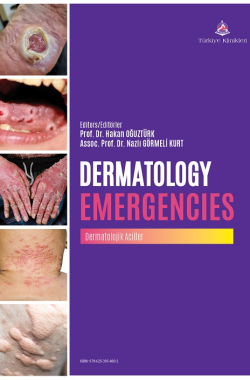Erythema Multiforme Minor
İsmail Ufuk YILDIZ
Ankara Bilkent City Hospital, Clinic of Emergency Medicine, Ankara, Türkiye
Yıldız İU. Erythema multiforme minor. In: Oğuztürk H, Görmeli Kurt N, eds. Dermatologic Emergencies. 1st ed. Ankara: Türkiye Klinikleri; 2025. p.80-4.
ABSTRACT
Erythema multiforme (EM) is an acute, often self-limited skin condition that can present with isolated, recurrent, or persistent lesions. It has two forms: Erythema Minor, affecting only the skin, and Erythema Major, involving mucocutaneous involvement. Previously thought to be part of the same spectrum as Stevens-Johnson Syndrome (SJS) and toxic epidermal necrolysis, EM is now recognized as a distinct disease. Epidemiology: EM has an incidence of less than 1% and is slightly more common in males, primarily affecting individuals aged 20-40. However, it can occur in all age groups, including children and the elderly. Etiology: EM is usually triggered by a cell-mediated immune response to infections, with over 90% of cases linked to such triggers. Herpes simplex virus (HSV) type 1 is the most common cause, but HSV-2 and Mycoplasma pneumoniae can also be involved. Drug-induced cases are less frequent, with common triggers including NSAIDs, antiepileptics, and antibiotics. Clinical Presentation: EM lesions begin as pink or red papules, potentially evolving into plaques. Classic “target” lesions have three concentric rings: a dark center, a paler ring, and an outer red ring. Lesions may also be atypical with only two zones. Lesions typically appear symmetrically on extremities and may affect the palms and soles. Diagnosis: Diagnosis is based on patient history, physical examination, and, if needed, biopsy. The presence of multiple typical or atypical target lesions smaller than 3 cm confirms the diagnosis. Treatment: Treatment varies based on severity and triggers. Mild cases may resolve spontaneously, managed with antihistamines, topical corticosteroids, and analgesics. Antiviral drugs like acyclovir are used in HSV-associated cases, and systemic corticosteroids are reserved for severe cases. Supportive care and follow-up are essential, especially for preventing complications.
Keywords: Erythema; erythema multiforme; Herpes simplex; urticaria; Stevens-Johnson syndrome
Kaynak Göster
Referanslar
- Sokumbi O, Wetter DA. Clinical features, diagnosis, and management of erythema multiforme: A review for the practicing dermatologist. Int J Dermatol. 2012;51(8):889-902. [Crossref] [PubMed]
- Assier H, Bastuji-Garin s, Revuz J, et al. Erythema multiforme with mucosal involvement and stevens-Johnson syndrome are clinically distinct disorders with different etiologies. Arch Dermatol. 1995;131(5):539-43. [Crossref] [PubMed]
- Lamoreux MR, sternbach MR, Hsu WT. Erythema multiforme. Am fam physician. 2006;74(11):1883-8. [PubMed]
- Hosaka H, Ohtoshi s, Nakada T, Iijima M. Erythema multiforme, stevensJohnson syndrome and toxic epidermal necrolysis: frozen-section diagnosis. J Dermatol. 2010;37(5):407-12. [Crossref] [PubMed]
- Huff JC, Weston WL, Tonnesen MG. Erythema multiforme: Critical review of characteristics, diagnostic criteria, and causes. J Am Acad Dermatol. 1983;8(6):763-75. [Crossref] [PubMed]
- Huff JC. Erythema multiforme. Dermatol Clin. 1985;3:141-60. [Crossref] [PubMed]
- Heinze A, Tollefson M, Holland KE, Chiu YE. Characteristics of pediatric recurrent erythema multiforme. pediatr Dermatol. 2018;35:97-101. [Crossref] [PubMed]
- Roujeau JC. Chapter 39: Erythema multiforme. In: Goldsmith LA, Katz sI, Gilchrest BA, paller As, Leffell DJ, Wolff K, eds. fitzpatrick's Dermatology in General Medicine. 7th ed. McGraw-Hill; 2008. [Link]
- Schalock pC, Dinulos JG, pace N, et al. Erythema multiforme associated with Mycoplasma pneumoniae infection in two children. pediatr Dermatol. 2006;23(6):546-55. [Crossref] [PubMed]
- Lerch M, Mainetti C, Terziroli Beretta-piccoli B, et al. Current perspectives on erythema multiforme. Clin Rev Allergy Immunol. 2018;54(1):177-84. [Crossref] [PubMed]
- Brice sL, Krzemien D, Weston WL, Huff JC. Detection of herpes simplex virus DNA in cutaneous lesions of erythema multiforme. J Invest Dermatol. 1989;93(2):183-7. [Crossref] [PubMed]
- Shin HT, Chang MW. Drug eruptions in children. Curr probl pediatr. 2001;31(7):207-34. [Crossref] [PubMed]
- Odom RB, James WD, Berger TG. Erythema and urticaria. Andrews' Diseases of the skin: Clinical Dermatology. 9th ed. saunders; 2000. p.146-51. [Link]
- Habif Tp. Hypersensitivity syndromes and vasculitis. Clinical Dermatology: A Color Guide to Diagnosis and Therapy. 4th ed. Mosby; 2004. p.626-34. [Link]
- Huff JC. Erythema multiforme and latent herpes simplex infection. semin Dermatol. 1992;11(3):207-10. [PubMed]
- Bastuji-Garin s, Rzany B, stern Rs, et al. Clinical classification of cases of toxic epidermal necrolysis, stevens-Johnson syndrome, and erythema multiforme. Arch Dermatol. 1993;129(1):92-6. [Crossref] [PubMed]
- Aurelian L, Ono f, Burnett J. Herpes simplex virus (Hsv)-associated erythema multiforme (HAEM): A viral disease with an autoimmune component. Dermatol Online J. 2003;9(1):1. [Crossref] [PubMed]
- Weston WL, Morelli JG. Herpes simplex virus-associated erythema multiforme in prepubertal children. Arch pediatr Adolesc Med. 1997;151:1014-6. [Crossref] [PubMed]

